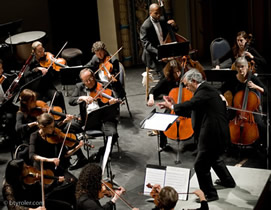When Greensboro Symphony Orchestra Music Director Dmitri Sitkovetsky is in town, one can expect to hear both orchestral and chamber music. He and Rice Toyota (the underwriter) have worked out a deal whereby the soloist that plays with the GSO on Thursday and Saturday nights will also play chamber music on Friday night. These chamber concerts have become a wonderful addition to the cultural life in Greensboro. Informality is key, no intermission interrupts the music making, and Sitkovetsky himself warms up the large audiences with tales about the literature about to be played. All takes place in UNCG’s School of Music Recital Hall.
This Friday featured cellist Julie Albers in works by Mozart and Shostakovich. Having just heard Albers play the pants off the first Shostakovich Cello Concerto, I looked forward to hearing her in a more intimate setting. Sitkovetsky explained that the pairing of the two works was the cellist’s idea, and although “Mozart didn’t trust cellists” (meaning not many tunes are given to that low string instrument), Albers couldn’t have chosen a better work from the classical repertoire — the Piano Trio in B-flat major, K. 502.
Musicologists and critics alike praise the work. Mozart biographer Alfred Einstein enthuses: “In every measure one finds the freshness, the nobility of invention and the inspired mastery that synthesize the contrasted elements of brilliance and intimacy, contrapuntal craftsmanship and gallanterie, into a higher unit.” And Homer Ulrich writes” “Drama, lyric beauty, charm, repose, fire — everything is there.” The three-movement work remains “among the great music of the Classical period.”
The playing was a model of classical sensibilities with Sitkovetsky playing first fiddle, Albers on cello and the indefatigable Inara Zandmane on piano. (Sitkovetsky pointed out that in addition to playing the two chamber works on Friday night, Zandmane was also accompanying a dozen singers who were in town for the Lynam Vocal Competition taking place over the weekend.) The keyboard matched lyric phrases from the violin, and impassioned playing from one player passed naturally to another. In short, the three musicians collaborated as if they were having a conversation. Chamber music the way it is supposed to be.
Violinist Stephanie Ezerman and violist Scott Rawls joined the trio for an intense performance of Shostakovich’s Piano Quintet in G minor, Op. 57. The composer wrote the quintet for the Beethoven Quartet (the best in Moscow) with himself at the keyboard, and critics immediately praised it, one calling it “a portrait of our age . . . the rich-toned, perfect voice of the present.” The work also won the Stalin Prize the next year, giving the composer 100,000 rubies, which he donated to those in need in Moscow.
The work is unusual in that it has five movements, with the first two being slow, the second of which is a fugue (derived from a Russian folk song). Tender solo lines intermix with dissonant clashes, but Shostakovich’s interest in the textural possibilities of the five instruments becomes one of the Quintet’s distinctive features.
The opening “Lento lugubre,” for example, begins with a grand statement from the piano to which the strings respond. The fugue introduces each string instrument in turn and eventually the piano contributes to the five- and six- independent lines. The Scherzo features furious fiddling from the strings with a romping tune in the piano.
Zandmane’s fiery playing brought out the extremes of registers (still another characteristic of the Quintet). Sitkovetsky, as always, offered sumptuous tone qualities with exquisite intonation, and Ezerman acted as a good companion in his music making. Rawls gave solid support to the middle of the texture, supplying leadership when called upon. And Albers furnished a firm foundation — her chamber music collaboration equals her talent as a soloist.
The musicians decided to recap the third-movement Scherzo as an encore; a lively ending to a superb evening of chamber music.











